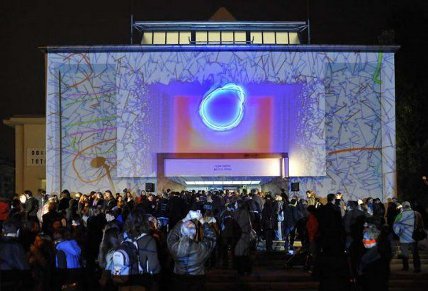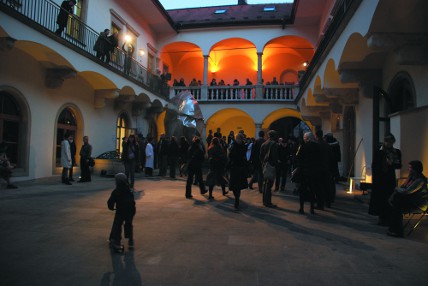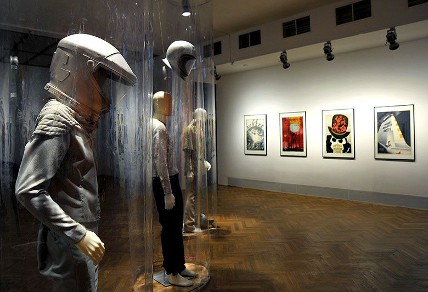 |
  |
 |

Lab: The Brno House of Arts, Brno, Czech Republic
Rostislav Koryčánek
|
 |
|
|
Times are changing. Also in the Brno House of Arts

Main building.

House of The Kunstat Lords, 99 Gallery.

Planeta Eden exhibition. Photo Michaela Dvořáková.
The Brno House of Arts is nourished and, at the same time, burdened by one simple fact: the history of this House goes back to 1911. The existence of the House of Arts can be seen against the background of the historical events that influenced not only the form and function of this institution, but the whole Central European area. To look at its hundred years of history is an enlightening excursion to the development of the role of a mediator of art and permits to observe gradual loosening up of the public assignment for an institution, which is devoted to the presentation of contemporary art.
The House of Arts, in all its past and present forms, has been acting as a "cultural hot spot" and was, in all of its stages, dedicated to presenting up-to-date art forms. At the same time, in all of its stages, there had been an additional motive to this general and honorable function, a motive, which is practical in its nature and thanks to which the house has lasted over its hundred years.
The House of Arts was created as the House of Artists and it became the homebase of the Moravian artists society, associating the German-speaking artists.
The House of Artists was a strategical cultural infrastructure, thanks to which it was possible to communicate between associated artists and the broad public. Beside the eagerness to share the poetic ideas about beauty, art and the exceptional role of the artist within the society, the motive of its existence was also the presumption that the association is a platform that enables a creator to meet potential buyers of his/her works.
The ethos of art as cultivator of the modern society, which longs for a different anchor than the one defined by economic or production means, is interwoven with the everyday reality of an artist who is attempting to enter these economic relations.
The role of the House of Artists changed after the war, when it was renamed the House of Arts. The aspiration to mediate the artistic view of the world was still present, but the economic motive, which had been binding the heterogenous members and their activities together, disappeared. On the other hand, the ideological emphasis on the role of art in society became more substantial. The creation of the socialist "positive art" was rocketing and its political advocates called for abundant representation.
The ideologisation of art exhibitions reached also the House of Arts. However, in the end, its role constituted in the opposition to the official cultural policy. A number of artists who where on the "black list" in Prague appeared in the exhibition halls of the House of Arts. The anti-regime spirit and the non-conformity made the House of Arts a cultural enclave, and it functioned as a magnet for like-minded artists and audience.
At the end of the 1980s, after the power was handed over from the representants of the communist regime to their opponents a general euphoria arose, and hence the loss of the role of mediator of an ideological alternative was not painful. Full acceptance of the new identity and role came only in the second half of the 1990s. Beside the awareness of the irreplaceable quality of the artistic exploration and the necessity of sharing the acquired knowledge with an audience as large as possible, there were the issues of building up a new image of a gallery institution, its services and infrastructure for the public and the internationalisation of the exhibition programme.
European galleries of similar type (non-collecting exhibition institutions), which didn't have to absorb so many ideological rebirths and which were or still are models for the House of Arts, were thinking about contemporary forms of exhibition institutions in a more progressive way. Their activities reflected such themes as education, entertainment, attractiveness, ambience, and community. It was a mixture of knowledge, diversion and identification. The latter plays a special role, also in the case of the House of Arts.
Recognition of an unmistakable identity is an essential marketing tool, also used in the administration of cities and other larger units. In this respect, an exhibition institution with a high-quality program and distinct architectural background is a suitable carrier of unmistakable identity and therefore an interesting component of the marketing and promotion of the city. For the visitor, it is an indicator of the cultural level of the city, etalon for comparing with other cities and, in the end, one of the reasons of his/her visit. Recent reconstruction of the House of Arts greatly contributed to the enlargement of the audience, improved the quality of the exhibition halls and helped to modify the exhibition programming: in the past two years, big exhibition projects appeared, characteristic of their time. Projects such as Formats of transformation, Planet Eden, Joel Peter Witkin, Exhibitor or Interior architecture also confirmed the very specific position of the House of Arts on the Czech visual arts scene, to a high degree defined by the non-functioning exhibition infrastructure in the centre of the cultural life in Prague.
Under these circumstances, the abundance of high-profile artists who do not have the possibility to exhibit, shifts the attention to the periphery, and the House of Arts is a well-established anchor point. Consolidation of the gallery environment in Prague - especially those who can offer sufficient exhibition surface and appropriate service - is thus postponed and it seems that the House of Arts could continue to profit from this persisting situation. Regrettably, at the moment it is rather difficult to communicate the purpose of the House of Arts to its provider, the statutory city of Brno. The issue is not so much the emphasis on the significance of being present in the national art scene, or on the weight of the fact that part of the scene is situated in Brno, thanks to which the cultural life in the city has a remarkable quality. What is more distressful is, that the political representation doesn't fully grasp the practical impact of the existence of a non-collecting exhibition institution in the marketing of the city and and its promotion. Therefore, the situation will be difficult in the near future, when part of the contributory organisations of the city will have to face severe cuts in their budgets. At the moment, it might seem that not even the utilitarian motive of existence of the House of Arts can guarantee its further existence. Despite this fact, I'm convinced, that the support of an exhibition institution and the preservation of its programme autonomy is one of the most economical uses of public financial resources.
|
poznámky a odkazy k článku
http://dum-umeni.cz
ďalšie články autora
Lab: Dům umění města Brna 27-28
|
   |
 |
 
<< < 1/1 > >>
|
 |
 |
 |
  |
 |
  |
 |
 |
©20023456789101112
atrakt art | emigre by
satori
|
|